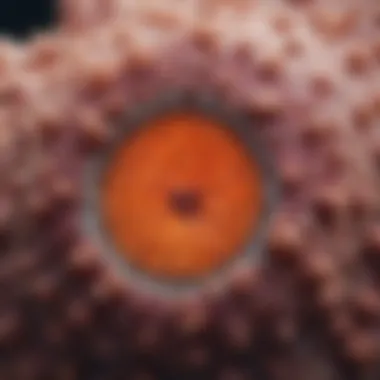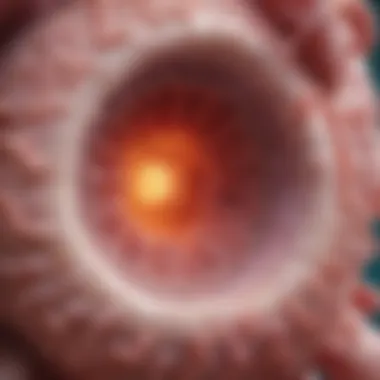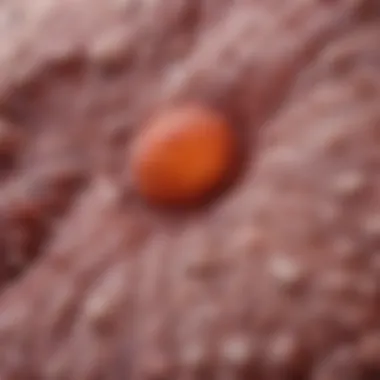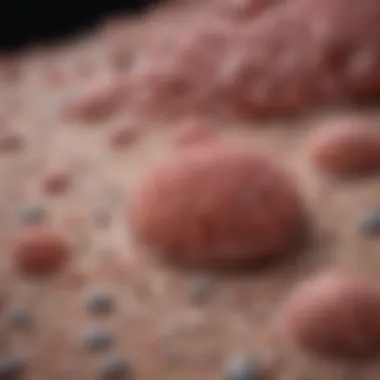Analyzing Squamous Cell Carcinoma and Perineural Invasion


Intro
Squamous Cell Carcinoma (SCC) is one of the most common forms of skin cancer, but its complexities can extend well beyond the skin. An often-overlooked aspect of SCC is its association with perineural invasion (PNI), where cancer cells invade the vicinity of nerves. Understanding this relationship is not just academic; it holds significant implications for diagnosis, staging, and ultimately, patient management. The current article sets out to explore these connections in depth, presenting findings that bridge gaps in existing knowledge.
In recent years, medical research has increasingly emphasized the role of PNI in predicting outcomes for patients with SCC. It is becoming increasingly clear that PNI can influence the prognosis, treatment decisions, and surveillance of SCC. This relationship is crucial not only for healthcare professionals but also for researchers and educators who are navigating the intricate landscape of cancer management.
Considering the complexity of SCC with PNI, one must dive into the nuances of recent research to fully grasp how these two factors interplay. This analysis aims to stitch together various strands of existing literature, enhancing the reader's understanding and providing a cohesive overview of the subject matter.
Prelims to Squamous Cell Carcinoma
Squamous cell carcinoma (SCC) emerges as a significant concern in the realm of oncology, especially given its prevalence and potential for aggressive behavior. This section lays the groundwork for understanding the intricate nature of SCC, intertwining crucial aspects such as its definition, epidemiology, and underlying biological mechanisms. The spotlight on SCC aims to illuminate why awareness and research into this cancer type are paramount, equipping healthcare professionals with knowledge vital for early diagnosis and effective treatment strategies.
Definition and Epidemiology
SCC is a type of skin cancer that arises from squamous cells, which are flat cells found in the outer layer of the skin as well as in certain mucosal linings. This carcinoma can also occur in other regions such as the lung, mouth, and esophagus. The World Health Organization estimates that SCC accounts for approximately 20% of all skin cancers, a number that has been on the rise over the past few decades due to factors like increased sun exposure and changes in lifestyle.
Statistical data indicate that there are about 1 million cases of non-melanoma skin cancers diagnosed each year, with SCC being the most common among them. It is more prevalent in individuals with fair skin, those with a history of UV exposure, and older adults. Certain risk factors are particularly relevant:
- Sunlight Exposure: Ultraviolet radiation is a significant contributor.
- Chemical Exposure: Prolonged contact with chemicals such as arsenic.
- Immunosuppression: Conditions that lower immune response increase susceptibility.
Pathophysiology of Squamous Cell Carcinoma
The pathophysiology of squamous cell carcinoma is complex, involving genetic mutations and alterations at the cellular level. Initially, these alterations may occur due to environmental factors like ultraviolet exposure, which cause DNA damage in squamous cells. As these damaged cells multiply uncontrollably, they can invade surrounding tissues.
SCC often displays unique cellular characteristics. For example, the presence of keratin pearls is a histological hallmark, underscoring the abnormal differentiation of keratinocytes. Such peculiarities in cellular behavior provide vital insights into the biological behavior of SCC:
- Invasion and Metastasis: SCC can spread locally and regionally, often suggesting perineural invasion, a process associated with poorer prognosis.
- Angiogenesis: Tumor cells can induce the formation of new blood vessels, aiding tumor growth.
- Inflammation: Infiltration of immune cells can lead to a tumor-promoting environment.
Understanding the pathophysiological underpinnings of SCC informs clinical approaches to diagnosis and management. Awareness of these biological processes can help tailor treatments and improve patient outcomes, marking the importance of insightful research in this field.
"A deeper comprehension of the intricacies of squamous cell carcinoma and its behaviors provides the tools for better clinical strategies."
In summary, gaining knowledge about squamous cell carcinoma not only establishes a crucial foundation for subsequent discussions on perineural invasion and staging but also emphasizes its growing significance in public health and clinical practice.
Understanding Perineural Invasion
Understanding perineural invasion (PNI) is crucial within the context of squamous cell carcinoma (SCC) because it significantly influences diagnosis, staging, treatment, and ultimately, patient outcomes. PNI occurs when cancer cells invade the space surrounding nerves, which can be a telling sign of aggressive disease. By recognizing and accurately assessing PNI, healthcare professionals can tailor their approaches to treatment more effectively. It is a topic that not only bears clinical relevance but also reflects advancements in cancer research and management, showing how our understanding of the disease evolves over time.
Definition of Perineural Invasion
Perineural invasion refers to the infiltration of tumor cells into the perineural space surrounding nerves. This is not merely an incidental finding; it can have significant implications for disease progression. It may indicate a higher potential for metastasis, which is the spread of cancer to other areas in the body. While traditionally viewed in older staging paradigms as an indicator of advanced disease, more recent studies point to the need for a nuanced understanding of this relationship. A tumor showing PNI might not even be the largest tumor present, but its ability to navigate through nerve structures could offer it new avenues for metastasizing or affect nearby tissues. Such characteristics make it a matter of high importance in terms of patient management.


Mechanisms of PNI in Carcinogenesis
The mechanisms behind PNI in SCC are complex and multifaceted.
- Biological Interactions: Tumors often secrete signaling molecules that can modify the behavior of peripheral nerves. This alteration leads to a permissive environment for tumor growth. For instance, cancer cells might influence nerve cells to release growth factors that fuel tumor expansion.
- Neurogenic Inflammation: There's a phenomenon called neurogenic inflammation, which can occur when nerve fibers are damaged by the invading tumor. This inflammation may not only facilitate cancer progression but also result in conditions like chronic pain for the patient.
- Nerve Growth Factor: The role of nerve growth factor (NGF) appears significant too. Tumors can affect the expression of NGF, which promotes nerve growth and can assist the tumor's ability to spread along neural pathways.
Understanding these mechanisms is vital for developing effective therapeutic strategies.
- Epithelial-to-Mesenchymal Transition: This transition allows cancer cells to acquire more invasive properties. When SCC cells undergo this change, they can detach from the primary tumor and invade nearby tissues, including nerves.
- Expression of Specific Markers: Some studies point to the correlation of certain markers expressed by SCC with the likelihood of PNI occurrence. These markers can become crucial figures for guiding clinical decisions.
In essence, a comprehensive grasp of how PNI operates at a cellular level adds depth to our understanding of squamous cell carcinoma. With this insight, practitioners can navigate the complexities of diagnosis and treatment more effectively for their patients.
Clinical Implications of PNI in SCC
The clinical implications of perineural invasion (PNI) in squamous cell carcinoma (SCC) are multifaceted and significant. As SCC cases present, the presence or absence of PNI can profoundly alter the course of diagnosis, therapy, and ultimately, patient outcomes. Understanding these implications is crucial for medical professionals who navigate the complexities of SCC, particularly given that PNI often indicates aggressive behavior and a tendency for recurrence.
Diagnostic Challenges
Identifying PNI in SCC is fraught with challenges. Its subtle manifestation makes early diagnosis difficult. Traditional imaging modalities, such as computed tomography (CT) and magnetic resonance imaging (MRI), may not always detect perineural involvement unless there's significant tumor bulk. This limitation necessitates a high index of suspicion among clinicians when diagnosing SCC.
"In many cases, histopathological examination is the gold standard for detecting PNI, yet even this can be prone to sampling errors."
Pathologists must scrutinize nerve sheaths carefully since the tumor’s microscopic infiltration around nerves can be overlooked. Thus, reliance solely on imaging without thorough histological evaluation can lead to missed diagnoses. The following factors contribute to diagnostic complexities:
- Variability in Reporting: Not all pathologists may report PNI consistently, leading to confusion in clinical settings.
- Symptomatology: Symptoms of PNI, such as pain or sensory changes, can easily be mistaken for other conditions.
- Tissue Sampling: Limited biopsies may not adequately reflect the true extent of PNI.
These challenges underscore the necessity for a multidisciplinary approach in managing SCC, integrating insights from radiologists, pathologists, and oncologists.
Impact on Prognosis
The presence of PNI in SCC carries serious prognostic implications. Studies have shown that patients with PNI exhibit a higher incidence of local recurrence and metastasis compared to those without it. This correlation suggests that PNI is not just a pathological finding but rather a harbinger of aggressive disease behavior.
Moreover, the prognosis is influenced by factors such as:
- Tumor Size: Larger tumors are often associated with a greater risk of PNI.
- Location: PNI in specific anatomical regions, such as the head and neck, can be more significant due to crucial neuroanatomical structures proximity.
- Histological Type: Certain variants of SCC are more prone to exhibiting PNI, such as those arising from the skin or oral cavity.
Understanding these factors helps tailor surveillance and treatment plans. Identifying patients at high risk necessitates prioritized management strategies to improve outcomes, emphasizing the inherent need for precise staging and tailored follow-ups.
Treatment Considerations
The presence of PNI complicates treatment strategies for SCC. Surgical margins become critical in planning excision. Surgeons may need to remove more tissue surrounding the affected nerves to achieve clear margins and minimize the risk of local recurrence. This often transitions into more extensive surgeries, which can raise the stakes for postoperative recovery and potential morbidities.


In addition to surgical alterations, PNI impacts adjunct treatment strategies:
- Radiation Therapy: Inclusion of PNI in treatment planning might require a change in radiation technique to encompass potential nerve involvement, guiding total dose and field.
- Chemotherapy: The additional risk posed by PNI might necessitate considering more aggressive chemotherapy regimens, particularly in advanced cases.
- Follow-Up Protocols: Patients with PNI need more frequent monitoring. This might include imaging and clinical assessments to catch recurrences promptly.
In summary, the clinical implications of PNI in SCC cannot be overstated. They shape diagnostic pathways, inform prognostic outcomes, and guide nuanced treatment selections. As research continues to unravel the complexities of PNI, staying abreast of the latest findings remains paramount for all stakeholders involved in combating this challenging malignancy.
Staging Systems for Squamous Cell Carcinoma
Staging systems serve as the backbone of cancer management, providing a uniform way to classify the extent of tumor spread and its characteristics. For squamous cell carcinoma (SCC), proper staging is particularly crucial as it influences treatment decisions, prognostication, and the overall management pathway. Knowledge of the staging mechanisms can empower healthcare professionals to tailor interventions appropriately and enable patients to grasp their prognosis. Furthermore, understanding how staging works helps in making comparisons between various studies and treatment plans, ultimately benefiting the ongoing pursuit of standardized healthcare practices.
Overview of Staging Approaches
Staging for SCC primarily hinges on the TNM system, which evaluates three fundamental components:
- T (Tumor Size and Extent): This aspect considers the size of the primary tumor and its local extent. It’s classified as T1 through T4, with increasing numbers signifying larger size or more extensive local invasion. For instance, T1 denotes tumors measuring less than 2 cm, while T4 indicates widespread local invasion.
- N (Lymph Node Involvement): This evaluates the presence of cancer in regional lymph nodes. N0 signifies no regional lymph node involvement, while N1-N3 categorizes increasing degrees of lymphatic spread, crucial for determining treatment.
- M (Distant Metastasis): This component examines whether the cancer has spread to distant sites. M0 represents no distant metastasis, while M1 indicates its presence.
These categories amalgamate to form a stage designation ranging from Stage I, indicating localized disease, to Stage IV, signifying advanced disease.
The Role of PNI in Staging
Perineural invasion (PNI) presents an added layer of complexity within the staging context of SCC. When it comes to how cancer cells infiltrate adjacent nerves, PNI can act as a powerful predictor, not just of local spread but also of future metastatic behavior.
It is essential to consider PNI when assessing SCC, as it often correlates with higher tumor grades and worse prognoses. The presence of PNI may warrant an upstaging of SCC in certain scenarios, as it suggests more aggressive biological behavior. Many clinicians may factor in PNI when determining treatment protocols, with some suggesting adjuvant therapy even in cases where tumors appear localized.
Comparison of Staging Systems
While the TNM classification is widely accepted, various organizations and research group have proposed alternative systems that take into account factors specific to SCC. Key differences in these staging systems can be important to note:
- AJCC Staging System: The American Joint Committee on Cancer emphasizes the role of clinical examination and imaging results. The AJCC system is particularly helpful in providing prognostic insights that can influence treatment.
- Brigham and Women’s Hospital System: This approach provides a unique perspective by introducing specific tumor details such as PNI status and other histological features into the staging criteria. This can lead to different staging outcomes compared to the TNM system alone.
- Memorial Sloan Kettering Cancer Center Guidelines: These guidelines incorporate detailed lymph node assessments as part of their staging criteria, emphasizing comprehensive node evaluation in guiding treatment decisions.
The differing frameworks highlight the importance of context and clinical judgment in staging SCC. They also underline how new insights into tumor biology and behavior can refine existing paradigms. Regardless of the staging system employed, incorporating PNI considerations into assessments is critical for achieving better patient outcomes and understanding disease behavior.
"The proper delineation of staging not only aids prognosis but also informs the treatment journey, emphasizing the need for a nuanced approach particularly in SCC cases with PNI."
By leveraging these staging systems, clinicians can make better-informed decisions and ultimately strive for targeted, effective therapies in managing squamous cell carcinoma.
Research Advances in PNI and SCC
The intricate relationship between squamous cell carcinoma (SCC) and perineural invasion (PNI) has been attracting significant attention in the field of oncology. Grasping the latest findings in this area not only hones our understanding but also informs clinical practices that could ultimately enhance patient outcomes. Research on the interaction of these two conditions is not just academic; it has profound implications for diagnosis, management, and treatment strategies.
Recent Findings on PNI Mechanisms


Recent studies have shed light on the biological underpinning of PNI in SCC. Researchers are delving into the molecular pathways that facilitate this invasion, seeking to understand how tumor cells exploit neural tissues for survival and progression.
Evidence has suggested that certain growth factors, such as nerve growth factor, may play pivotal roles in the process. These findings provide a window into the mechanisms at work, revealing that cancer cells can manipulate their microenvironment to foster an invasive phenotype.
Moreover, it has been noted that inflammatory mediators contribute to the development of PNI. These interactions highlight a complex dance between tumor and nerve cells that can reveal therapeutic targets.
"Understanding the mechanisms of perineural invasion could offer new avenues for targeted therapies that disrupt this cancer-promoting interaction."
Innovative Approaches in Diagnosis
When it comes to diagnosing SCC with PNI, traditional imaging techniques may not always suffice. New methods are emerging, utilizing advanced imaging modalities such as MRI and PET scans. These technologies enable clinicians to visualize perineural spread more effectively, offering a clearer picture of tumor extension.
In addition, liquid biopsies are on the rise as a diagnostic tool. By analyzing tumor markers in the blood, healthcare providers can gain insights into the presence of PNI without invasive procedures. This non-invasive approach holds promise for rapid and accurate diagnosis, allowing for timely intervention.
Emerging Therapeutic Strategies
The landscape of treatment for SCC with PNI is evolving. Targeted therapies, particularly those aimed at inhibiting the factors that promote PNI, are being explored. Drugs that block nerve growth factors, for instance, may slow tumor invasion along nerves, providing a fresh perspective on treatment options.
In combination with traditional approaches like surgery and radiation, these emerging therapies might deliver multidimensional benefits, particularly for patients with high-risk tumors. Researchers are also investigating immunotherapy as a possible avenue, where the body’s immune system is rallied to combat the cancer more effectively.
Summary
The advances in understanding the interplay between SCC and PNI are substantial. They not only enhance our grasp of the disease process but also invite opportunities for improved diagnostic tools and tailor-made treatment strategies. As research continues to unfold, it remains vital for healthcare professionals to stay abreast of these developments. By doing so, they are better equipped to navigate the complexities of SCC management, ensuring patient care remains at the forefront.
Culmination and Future Directions
In the complex landscape of squamous cell carcinoma (SCC), understanding the nuances of perineural invasion (PNI) is not just academic; it has real-world implications for diagnosis and treatment. The conclusions drawn from exploring the interplay between SCC and PNI provide critical insights that can shape future medical practices and research endeavors. The importance of this analysis lies in its potential to influence clinical decision-making pathways and patient outcomes.
Summary of Key Points
The inception of our discussion highlighted the fundamental nature of SCC and its alarming prevalence. PNI emerged as a significant factor affecting prognosis and staging. Specifically, key points include:
- Definition of PNI: Perineural invasion refers to cancer’s tendency to spread along nerves, which complicates surgical interventions and increases recurrence risks.
- Clinical Implications: The presence of PNI indicates a poorer prognosis, demanding more rigorous follow-up and management strategies.
- Staging Considerations: Recognizing PNI as a component of staging can lead to more tailored treatment protocols, reflecting an improved understanding of tumor biology.
These elements highlight the pressing need for clinicians to account for PNI in their evaluative framework, influencing therapeutic decisions.
Implications for Clinical Practice
The findings from this article shed light on how integrating PNI into clinical practices can enhance overall patient care. Clinicians should take heed of the following considerations:
- Enhanced diagnostic protocols: Incorporating PNI assessment into imaging and biopsies can lead to more accurate staging, thus paving the way for effective treatment.
- Personalized treatment plans: Understanding the invasive potential of SCC with PNI allows for the customization of therapies—including surgery, radiation, or systemic treatments—to better suit individual patient profiles.
- Monitoring Recurrence: Patients presenting with PNI may require more vigilant follow-up as the likelihood of recurrence is heightened in such cases. Regular assessments could ensure that any signs of cancer return are caught early, thereby improving survival chances. Knowing these implications can spell the difference between conventional care and a more nuanced approach that anticipates the challenges posed by PNI.
Areas for Further Research
While the current understanding of SCC and PNI bases itself upon solid findings, many questions remain unanswered, pointing to a plethora of future research opportunities. Vital areas for exploration include:
- Mechanisms of PNI: Further studies are needed to delve deeper into the biological processes contributing to PNI. Understanding these mechanisms could uncover novel therapeutic targets.
- Longitudinal Studies: Investigation into how patients with PNI fare over extended periods could yield insights into long-term management and help refine staging criteria.
- Comparative Effectiveness Research: Evaluating different treatment protocols for SCC patients with PNI could help identify which strategies provide the best outcomes, tailoring interventions to enhance efficacy.
"The future of treatment for SCC in the context of PNI hinges not merely on existing knowledge but on the intricate layers yet to be explored."
In summary, the integration of PNI within the broader context of SCC represents not merely a clinical nuance but a pivotal element that shapes our understanding and response to this aggressive cancer. Moving forth, a focused lens on research endeavors promises to illuminate new pathways toward better diagnostics, treatment modalities, and potentially, improved survival rates for those affected by this disease.



